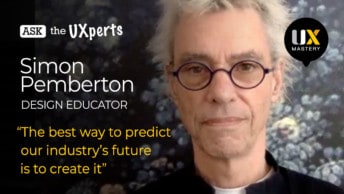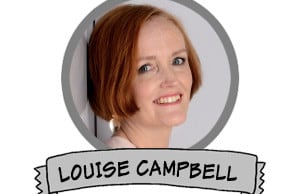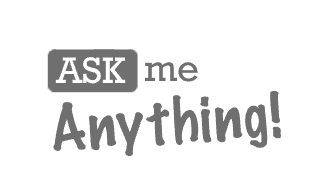For quite some time now we’ve been successfully running Ask the UXperts live chats in our Campfire chatroom. Those sessions are fast paced and full on. They also rely heavily on people being available to participate at a certain time. Last week we decided to give something a bit different a try. We started up a dedicated thread on our community forums and threw Luke to the wolves.
We gave you the opportunity to ask Luke anything – no holds barred – and you didn’t let us down.
If you didn’t make it to the session, fear not, the thread is still running. Feel free to jump in and ask any pressing questions that you might have.
Here is a summary of some of the highlights, for your reading pleasure.
Ash came at Luke hard and fast, with some highly entertaining questions. My personal favourite was “What is the most revolting thing you have ever eaten?” to which Luke replied
“Seagull poo. And not voluntarily, either! Salty, fishy and highly disgusting. I had to run 500 metres to the nearest tap.”
Not to be outdone, I asked Luke that age-old question “Would you rather fight 100 duck-sized horses or one horse-sized duck?” and ever the nice guy, this is what he said:
“I’d rather fight one horse-sized duck. It allows me to focus my efforts on a single adversary, and if the physicists are correct it would be too big to fly anyway! I’m not sure if I’d feel more guilty knocking off a mighty horse-sized duck, or being responsible for the genocide of a hundred duck-sized horses. Poor little critters.”
At that point we decided to get a bit more serious, with a great question from Leigh: “What are your thoughts on the importance of interaction design and is this a role you find comes into your every day work?” The answer was
“Yes, definitely. I see interaction design as being at the pointy end of UX, where people are directly engaging with the design assets. Decisions made during a UX design process will have a huge impact, and be measurable, during these interactions.
This contrasts with other UX-type roles, such as information architects, or user researchers, where the importance is less immediately obvious.
However, I do think that several UX roles, operating across the UX spectrum, are essential in a design project so that there are no gaps in how the team works together.”
Because we get a lot of questions in the community about the best way to find a mentor, I decided to ask Luke for his top tips.
“Yep, that’s a common question! It has a couple of different responses, but an answer is really hard – it’s not easy to find a good mentor.
Firstly, I think your aptitude and the way you want to learn has a big influence on what you will need. Some people just need someone to look to for occasional career advice and the benefit of an honest opinion on their skills. Other people need something a lot more intensive and may find a mentor who can give them that kind of attention.
Remember that your mentor is being very generous in sharing their time with you. Don’t suck them dry, but also make the most of your time. I see a lot of people who expect their mentor to teach them, but really they should be learning from their mentor. There is a subtle but important difference.
Good places to find mentors are wherever you discuss your profession. Don’t jump right in, though. Take plenty of time (I mean weeks or months) to get to know each other professionally. You’ll then get a feel for if it is the right time to ask them formally if they’ll help you.
There are quite a few posts in these forums, and articles on the main website’s blog with responses to people’s specific questions. If you’re curious about this, I’d also strongly recommend getting a copy of the Get Started in UX ebook that Matt and I wrote – we poured all of our thinking into it, including steps for finding a mentor. See: http://uxmastery.com/get-started-in-ux/
I know the above is a very broad response – happy to answer specific questions if you let me know!”
Leigh jumped in with another insightful question: “How do you deal with justifying your quote and the process to the client?”
The early scoping work and the education/evangelising about a UX approach fit nicely together. They’re clearly paying for expertise in building a solution, and there are a lot of clear indications that taking a client along with you on the journey will allow a vastly better final result.
For larger projects, or projects/clients where they have some concerns, the scoping process itself will be a mini project. this also allows us to demonstrate effectiveness before they commit money and reputation to something they’re unsure of.
As with any kinds of consulting, managing scope and expectations is important. I’ve found that clear, open and honest communication builds trust, especially when you have a mature and objective process behind a creative approach. This is one of the key reasons I love UX. =)
Visualbug then joined in with “I have no idea, as an entry level UX or UI designer, what would be a fair salary.”
Two important things to consider when determining your salary:
1) What amount do you actually and honestly feel that you’re worth? Not just how much you think you can get. For job satisfaction to mean something, and to work sustainably, you need to have it low enough that you don’t feel like a fake, and not so high that you’re under too much pressure to prove yourself. Remember too that taking a lower salary at some point in the future may make you feel like you’re not being paid what you’re worth, so don’t ask too much too early, and aim to steadily increase over your career.
2) How much value are you giving to the people you work for? You need to get a sense of what sets you apart from your peers, where you are valuable and where you are not. Go for the jobs where you can honestly add something, stay away from jobs where you can’t. If you can identify a skill level that reflects what you bring (role description, years experience, specialisations, geographic location, etc) and can see similarities in your peers, then you might be able to aim for the same salary. You can check ‘salary survey’ results, often available online. They’ll give you an idea of what the marketplace is actually offering.
For smaller freelance clients, its a balance between what they can afford, and the best ways you can help them. If they can afford more, they’ll be giving you more opportunity to help. If they can only afford a little, you’ll just be able to get them started (or not at all). It is important that you get paid though – working for free isn’t always the best you can offer them!
If you’re just getting started in a junior position, be grateful for the experience you’re able to get. UX is very lucky to be in demand, so more opportunities are available, but don’t let it go to your head.
Look for workplaces that give you satisfaction that isn’t just based on salary. From experience, these places will be the best places for you to grow, be challenged, share with colleagues and live your life.
Kibou asked another question that we hear a lot on the forums, which was “How can we create a project on our own if we don’t have a client or a team to work with?” to which Luke offered some more excellent advice:
The short answer is to look for any design problem, and then solve it, or solve it better than before. Some people also say that design is more than just problem solving – that it’s a balance between constraints and your new discoveries. Lucky for us there are a bajillion UX design problems still to solve. Good designers notice problems and make improvements. They can’t help it.
If you’re looking for some inspiration, Pete Smart went on a journey to solve 50 design problems in 50 days, and Josh Porter has written some great stuff on the ’52 Weeks of UX’ blog about how to identify design problems.
So, I’d suggest you find a problem and just jump into designing a response, following a UX process. You’ll need to act as your own client, but there’ll also be a freedom to explore that will hopefully generate some good artefacts for your portfolio and experience. You’ll still be able to head out and interview people relevant to the problem. If you work better bouncing ideas of someone, or being given some constraints, then get a friend to act as the client.
The long answer comes back to a philosophy of design. My personal take on that (and one of the founding principles of UX Mastery) is a direct response to Victor Papanek’s provocative opening salvo in his seminal text from 1971 ‘Design for the Real World‘:
“There are professions more harmful than industrial design, but only a few of them… by creating whole species of permanent garbage to clutter up the landscape, and by choosing materials and processes that pollute the air we breathe, designers have become a dangerous breed, and the skills needed for these activities are taught carefully to young people.”I see user experience design as a digital descendant of industrial design, and take a responsibility for the things I create, and for encouraging others to do the same.
John Allsop (founder of the Web Directions conferences) sent out an email this morning that I’ll share here too. In it, he quoted Mike Montiero (a prominent and insightful author and designer from San Francisco who likes to use strong language and call a spade a spade) from his recent blog post about the design of the AK-47 by Mikhail Kalashnikov. Montiero was unequivocal, and said “If a thing is designed to kill you, it is, by definition, bad design.” He goes on to say that design is an ethical trade.
Scott Berkun (an author and speaker, and former usability engineer at Microsoft) responded to Montiero with a correction, saying that design should be an ethical trade, but isn’t currently: “Modern design is dominated by consumerism and while consumerism has been great for the economy it has also been bad for the planet and for the human psyche.”
Former Twitter design manager Cennnyd Bowles comments on the place of ethics in digital design: “Designers as such have a central role in safeguarding digital products so they not only empower but also protect users.”
Taking the thinking of Papanek, Montiero, Berkun and Bowles, there is a massive challenge to consider the impact and intent of our design work. So find something worth working on, and give it a go. =)
And that is probably more than enough for a round-up! There were a great many other brilliant questions asked, so make sure you do jump onto the forums and read through the entire thread.
We learned a lot from our first attempt at an AMA. Next time, rather than running it over one hour, we’ll go for a monumental 24 hours. That way you’ll all get an opportunity to take part at a time that suits you. Make sure you join us for that – we’ll announce the details here once we have them finalised.





